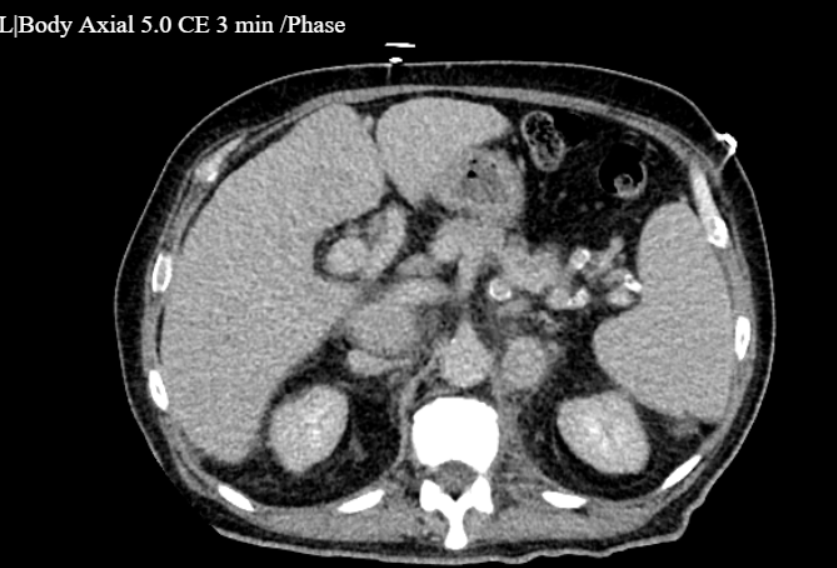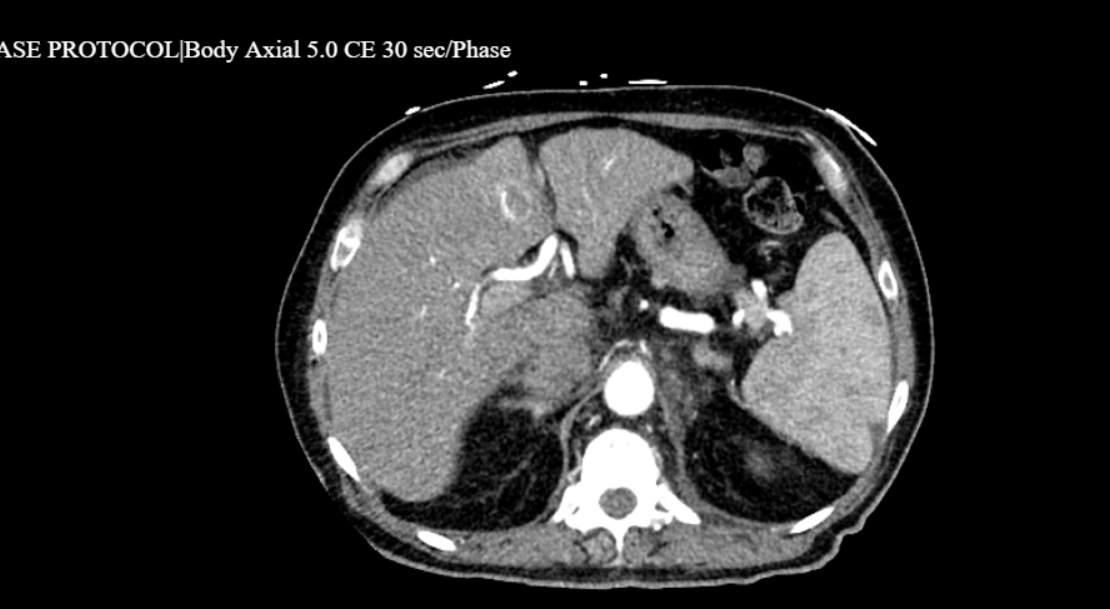Tuesday Poster Session
Category: Liver
P6147 - Paraneoplastic Leukemoid Reaction in a Patient With Poorly Differentiated Hepatocellular Carcinoma: A Rare and Aggressive Presentation
Tuesday, October 28, 2025
10:30 AM - 4:00 PM PDT
Location: Exhibit Hall
.jpg)
Vinesh Kumar, MD
New York Medical College - Saint Michael's Medical Center
Kearny, NJ
Presenting Author(s)
Vinesh Kumar, MD1, Wajeeha Aiman, MD2, Fnu Sandhiya, MD1, Hamid Shaaban, MD2, Gunwant Guron, MD2, Theodore DaCosta, Jr., MD2
1New York Medical College - Saint Michael's Medical Center, Kearny, NJ; 2New York Medical College - Saint Michael's Medical Center, Newark, NJ
Introduction: Paraneoplastic leukemoid reaction (PLR) is a rare but serious complication of solid tumors, characterized by extreme leukocytosis in the absence of infection or hematologic malignancy. It is associated with cytokine secretion by the tumor and signifies poor prognosis. PLR in hepatocellular carcinoma (HCC) is infrequently reported.
Case Description/
Methods: A 72-year-old male with a history of hypertension, hydrocele, and a biventricular pacemaker presented with progressive weight loss, anorexia, and episodic nausea. Imaging revealed liver cirrhosis with a right hepatic mass and extensive retroperitoneal lymphadenopathy. Triple-phase CT and biopsy confirmed poorly differentiated hepatocellular carcinoma. Serum alpha-fetoprotein was markedly elevated ( >1000 ng/mL).
During hospitalization, the patient developed progressive leukocytosis, with WBC counts rising from 29.3 ×10⁹/L to >94 ×10⁹/L and neutrophilic predominance (91.9%) without evidence of infection or myeloproliferative disease. Inflammatory markers were negative, and peripheral smear revealed mature neutrophilia with rare immature cells. These findings were consistent with a paraneoplastic leukemoid reaction, likely mediated by tumor-derived granulocyte colony-stimulating factor (G-CSF).
Despite preserved liver function and acceptable performance status, imaging demonstrated rapid disease progression with new psoas infiltration and worsening adenopathy. The patient was not a candidate for curative or locoregional therapy and was initiated on systemic immunotherapy. Palliative care was engaged for symptom management and goals of care discussions.
Discussion: This case highlights paraneoplastic leukemoid reaction as a rare and aggressive manifestation of advanced HCC. Early recognition is critical, as it often indicates poor prognosis and may mimic infectious processes. Clinicians should maintain a high index of suspicion in patients with rapidly rising neutrophilic leukocytosis and advanced malignancy.

Figure: CT abdomen early washout phase suggest right lobe mass.

Figure: CT abdomen and pelvis showing multiple retroperitoneal nodes
Disclosures:
Vinesh Kumar indicated no relevant financial relationships.
Wajeeha Aiman indicated no relevant financial relationships.
Fnu Sandhiya indicated no relevant financial relationships.
Hamid Shaaban indicated no relevant financial relationships.
Gunwant Guron indicated no relevant financial relationships.
Theodore DaCosta, Jr. indicated no relevant financial relationships.
Vinesh Kumar, MD1, Wajeeha Aiman, MD2, Fnu Sandhiya, MD1, Hamid Shaaban, MD2, Gunwant Guron, MD2, Theodore DaCosta, Jr., MD2. P6147 - Paraneoplastic Leukemoid Reaction in a Patient With Poorly Differentiated Hepatocellular Carcinoma: A Rare and Aggressive Presentation, ACG 2025 Annual Scientific Meeting Abstracts. Phoenix, AZ: American College of Gastroenterology.
1New York Medical College - Saint Michael's Medical Center, Kearny, NJ; 2New York Medical College - Saint Michael's Medical Center, Newark, NJ
Introduction: Paraneoplastic leukemoid reaction (PLR) is a rare but serious complication of solid tumors, characterized by extreme leukocytosis in the absence of infection or hematologic malignancy. It is associated with cytokine secretion by the tumor and signifies poor prognosis. PLR in hepatocellular carcinoma (HCC) is infrequently reported.
Case Description/
Methods: A 72-year-old male with a history of hypertension, hydrocele, and a biventricular pacemaker presented with progressive weight loss, anorexia, and episodic nausea. Imaging revealed liver cirrhosis with a right hepatic mass and extensive retroperitoneal lymphadenopathy. Triple-phase CT and biopsy confirmed poorly differentiated hepatocellular carcinoma. Serum alpha-fetoprotein was markedly elevated ( >1000 ng/mL).
During hospitalization, the patient developed progressive leukocytosis, with WBC counts rising from 29.3 ×10⁹/L to >94 ×10⁹/L and neutrophilic predominance (91.9%) without evidence of infection or myeloproliferative disease. Inflammatory markers were negative, and peripheral smear revealed mature neutrophilia with rare immature cells. These findings were consistent with a paraneoplastic leukemoid reaction, likely mediated by tumor-derived granulocyte colony-stimulating factor (G-CSF).
Despite preserved liver function and acceptable performance status, imaging demonstrated rapid disease progression with new psoas infiltration and worsening adenopathy. The patient was not a candidate for curative or locoregional therapy and was initiated on systemic immunotherapy. Palliative care was engaged for symptom management and goals of care discussions.
Discussion: This case highlights paraneoplastic leukemoid reaction as a rare and aggressive manifestation of advanced HCC. Early recognition is critical, as it often indicates poor prognosis and may mimic infectious processes. Clinicians should maintain a high index of suspicion in patients with rapidly rising neutrophilic leukocytosis and advanced malignancy.

Figure: CT abdomen early washout phase suggest right lobe mass.

Figure: CT abdomen and pelvis showing multiple retroperitoneal nodes
Disclosures:
Vinesh Kumar indicated no relevant financial relationships.
Wajeeha Aiman indicated no relevant financial relationships.
Fnu Sandhiya indicated no relevant financial relationships.
Hamid Shaaban indicated no relevant financial relationships.
Gunwant Guron indicated no relevant financial relationships.
Theodore DaCosta, Jr. indicated no relevant financial relationships.
Vinesh Kumar, MD1, Wajeeha Aiman, MD2, Fnu Sandhiya, MD1, Hamid Shaaban, MD2, Gunwant Guron, MD2, Theodore DaCosta, Jr., MD2. P6147 - Paraneoplastic Leukemoid Reaction in a Patient With Poorly Differentiated Hepatocellular Carcinoma: A Rare and Aggressive Presentation, ACG 2025 Annual Scientific Meeting Abstracts. Phoenix, AZ: American College of Gastroenterology.
